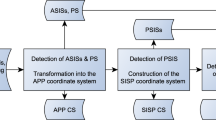Abstract
In three-dimensional reconstruction of the human spine obtained from stereoradiographic setpus (two radiographs or more), it is extremely difficult to identify exactly the same landmarks on all radiographs. The effect of these identification errors was investigated with simulations made on points of known three-dimensional co-ordinates and compared with three-dimensional reconstructions of real spines obtained with the direct linear transformation algorithm. Results showed that radiographic identification errors of up to 2 mm were common, causing reconstruction errors of up to 5mm. These reconstruction errors may be noticed in the form of geometrical inaccuracies in the graphical representation of three-dimensional reconstructions of the spine. Successive displacements were then imposed on image point co-ordinates to minimise the identification error and increase the reconstruction accuracy. The improvement on the three-dimensional reconstruction results was negligible. Three-dimensional reconstructions obtained from three radiographs were also investigated. They showed slightly more accurate reconstructions than those obtained from two radiographs. However, the increase of X-ray exposure on the patient may not be worthwhile.
Similar content being viewed by others
References
André, B., Dansreau, J. andLabelle, H. (1990) Geometric evaluation of the three-dimensional reconstruction of the spine from different vertical stereoradiographic setups. Proc. Canadian Soc. of Mech. Eng. Forum, Toronto, Canada, 55–59.
André, B. andDansereau, J. (1991) Effect of a third radiograph on the three-dimensional reconstruction accuracy of the human spine. Proc. Int. Symp. on Three-Dimensional Analysis of Human Movement, Montréal, Canada, 23–26.
Brown, R. H., Burstein, A. H., Nash, C. L. andSchock, C. C. (1976) Spinal analysis using a three-dimensional radiographic technique.J. Biomech.,9, 355–365.
Dansereau, J. andStokes, I. A. F. (1988) Measurement of the three-dimensional shape of the rib cage,,21, 893–901.
DeSmet, A. A., Tarlton, M. A., Cook, L. T., Berridge, A. S. andAsher, M. A. (1983) The top view for analysis of scoliosis progression.Radiol.,147, 369–381.
Hindmarsh, J., Larsson, J. andMattsson, O. (1980) Analysis of changes in the scoliotic spine using a three-dimensional radiographic technique.J. Biomech.,12, 279–290.
Kling, T. F., Cohen, M. J., Lindseth, R. E. andPaul de Rosa, G. (1990) Digital radiography can reduce scoliosis X-ray exposure.Spine,15, 880–885.
Kratky, V. (1975) Analytical programmetry in scoliosis.Photogrammetria,31, 195–210.
Marzan, G. T. (1976) Rational design for close-range photogrammetry. Ph.D. Dissertation, Department of Civil Engineering, University of Illinois at Urbana-Champaign, USA.
Olsson, T. H., Selvik, G. andWillner, S. (1976) Kinematic of spinal fusion.Invest. Radiol.,11, 202–209.
Pearcy, M. J. (1985) Stereo radiography of lumbar spine.Acta Orthop. Scand.,56, Suppl. 212, 1–49.
Plamondon, A. (1989) Validation d'une méthode stéréoradiographique pour l'étude des déplacements intervertébraux lombaires. Ph.D. Dissertation, Department of Physical Education, University of Montréal, Canada.
Rab, G. T. andChao, E. Y. S. (1977) Verification of roentgenographic landmarks in the lumbar spine.Spine,2, 287–293.
Stokes, I. A. F., Medlicott, P. A. andWilder, D. G. (1980) Measurement of movement in painful intervertebral joints.Med. & Biol. Eng. & Comput.,18, 694–700.
Stokes, I. A. F., Bigalow, L. C. andMoreland, M. S. (1987) Three-dimensional spinal curvature in idiopathic scoliosis.J. Orthop. Res.,5, 102–113.
Wolf, P. R. (1983)Elements of photogrammetry, 2nd edn. McGraw Hill, 559–571.
Wood, G. A. andMarshall, R. N. (1986) The accuracy of DLT extrapolation in three-dimensional film analysis.J. Biomech.,19, 781–785.
Author information
Authors and Affiliations
Rights and permissions
About this article
Cite this article
André, B., Dansereau, J. & Labelle, H. Effect of radiographic landmark identification errors on the accuracy of three-dimensional reconstruction of the human spine. Med. Biol. Eng. Comput. 30, 569–575 (1992). https://doi.org/10.1007/BF02446787
Received:
Accepted:
Issue Date:
DOI: https://doi.org/10.1007/BF02446787




